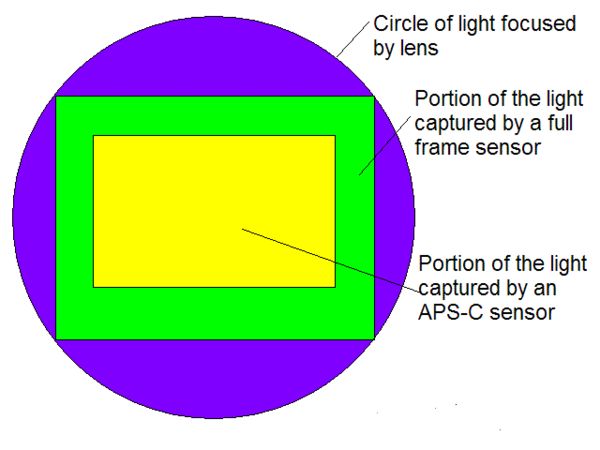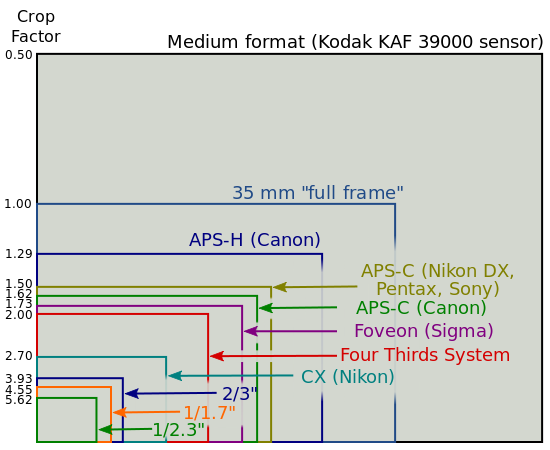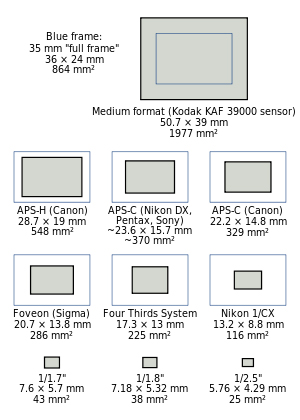digital photography
Feb 9, 2014 21:36:00 #
roy4711
Loc: Spring Valley IL.
I need help understanding digital photography. Nikon 100mm lens becomes 150mm does that mean the zoom is greater or with the sensor being smaller the zoom is the same and the angle of view is equal to a150mm lens.
Feb 9, 2014 21:41:16 #
This diagram may help you understand about "crop factor". Any given lens will project the same field-of-view on every camera. The difference is the size of each camera's sensor.
"Full frame" (FX) digital cameras have sensors the same size as 35-mm film ratio used in film cameras: 24-mm x 36-mm.
"Cropped" (DX) digital cameras have smaller sensors (approx 16-mm x 24-mm) which see & record a smaller area of the image projected by the lens. This is generically called an APS-C size sensor.
On Sony, Fuji, Nikon DX, and other APS-C cameras, we use a crop factor of 1.5x to figure the apparent view, which would match the lens needed on a 35-mm film camera to capture the same field-of-view.
On Canon APS-C cameras (slightly smaller sensors), we use a crop factor of 1.6x to figure the apparent view, which would match the lens needed on a 35-mm film camera to capture the same field-of-view.
Read more here: FAQ: Sensor Sizes Chart & Comparative Format Views at http://www.uglyhedgehog.com/t-26503-1.html
"Full frame" (FX) digital cameras have sensors the same size as 35-mm film ratio used in film cameras: 24-mm x 36-mm.
"Cropped" (DX) digital cameras have smaller sensors (approx 16-mm x 24-mm) which see & record a smaller area of the image projected by the lens. This is generically called an APS-C size sensor.
On Sony, Fuji, Nikon DX, and other APS-C cameras, we use a crop factor of 1.5x to figure the apparent view, which would match the lens needed on a 35-mm film camera to capture the same field-of-view.
On Canon APS-C cameras (slightly smaller sensors), we use a crop factor of 1.6x to figure the apparent view, which would match the lens needed on a 35-mm film camera to capture the same field-of-view.
Read more here: FAQ: Sensor Sizes Chart & Comparative Format Views at http://www.uglyhedgehog.com/t-26503-1.html

Feb 9, 2014 22:11:16 #
Small correction, Nikonian: You have Olympus listed with the cameras with a crop factor of 1.5
The crop factor for the 4/3 sensor Olympus uses, is actually 2.
The crop factor for the 4/3 sensor Olympus uses, is actually 2.
Feb 9, 2014 22:15:32 #
roy4711 wrote:
I need help understanding digital photography. Nikon 100mm lens becomes 150mm does that mean the zoom is greater or with the sensor being smaller the zoom is the same and the angle of view is equal to a150mm lens.
There are two different format cameras that take the same lenses.
Canon, Nikon and some others make both. With the "full-frame" bodies, the 100mm lens has the same field of view as it would on a 35mm film camera. If you put that same lens on the smaller sensor cameras, you get a narrower and of view. The focal length does not change with the smaller APS-C cameras, just the angle of view because the imaging area is smaller.
There are other size sensors than these, but a lot of confusion happens with full-frame and APS-C sensors, I think because the same lenses that work on the bigger sensor cameras can be used on the smaller.
Feb 9, 2014 22:28:43 #
Morning Star wrote:
Correct. Olympus removed from APS-C list.Small correction, Nikonian: You have Olympus listed with the cameras with a crop factor of 1.5
The crop factor for the 4/3 sensor Olympus uses, is actually 2.
The crop factor for the 4/3 sensor Olympus uses, is actually 2.
This chart compares 4/3 sensor size to APS-C and full frame sensors.

Feb 9, 2014 23:04:12 #
I was recently asked: "why did't the camera makers stick with one sensor size like full frame as I remember in film cameras, is it because of the cost?"
Answer: Film cameras had several different formats, including 8x10, 4x5, 126, 120, 70-mm, 135 (35-mm), 110, half-frame, Minox, etc. Here are the current sensor sizes, from full-frame to cellular telephone.
Answer: Film cameras had several different formats, including 8x10, 4x5, 126, 120, 70-mm, 135 (35-mm), 110, half-frame, Minox, etc. Here are the current sensor sizes, from full-frame to cellular telephone.

Feb 9, 2014 23:07:34 #
Nikonian72 wrote:
I was recently asked: "why did't the camera makers stick with one sensor size like full frame as I remember in film cameras, is it because of the cost?"
It certainly would have kept the confusion down.
Feb 9, 2014 23:10:06 #
Feb 9, 2014 23:19:46 #
I have a hard time understanding what difference any of this makes at all. I just snap the shutter when I have what I want in the viewfinder.
Feb 9, 2014 23:23:56 #
amehta
Loc: Boston
roy4711 wrote:
I need help understanding digital photography. Nikon 100mm lens becomes 150mm does that mean the zoom is greater or with the sensor being smaller the zoom is the same and the angle of view is equal to a150mm lens.
The lens does not change, it is still a 100mm lens. There is no change in magnification or "reach".
The field of view which the DX sensor captures is the same as the field of view which an FX sensor would capture with a 150mm lens. So the DX sensor shows less of the scene.
The "effective" magnification changes when the full image is displayed, either on a monitor or a print. If you are making a 24x36 inch print, the FX image needs to be magnified by 25x, while the DX image needs to be magnified by 38x. That is the other place where the 1.5x factor comes up.
Feb 9, 2014 23:29:24 #
Whuff wrote:
When you do want to understand the difference, this is the forum to ask.I have a hard time understanding what difference any of this makes at all.
Feb 9, 2014 23:38:45 #
I don't know this is the reason for full frame and crop sensor models but it may be cost and marketing. The crop sensor cameras are less expensive and are targeted as "consumer " items while FF cameras are sold as "pro" cameras. If all cameras were over $ 3,000 as full frames with lens are much fewer would be sold. Your basic hobby photographer (as am I ) would be forced to a point and shoot or cell phone camera. Again I do not know that any of this is accurate, but it sound possible to me.
Feb 9, 2014 23:38:53 #
amehta
Loc: Boston
Whuff wrote:
I have a hard time understanding what difference any of this makes at all. I just snap the shutter when I have what I want in the viewfinder.
If you are happy with the photos you are getting, then it's great. :-)
Feb 9, 2014 23:41:26 #
amehta
Loc: Boston
boberic wrote:
I don't know this is the reason for full frame and... (show quote)
There are technical, engineering factors as well. It is not easy to fabricate the full frame sensor. Consider the difference between computers today and those from 10-20 years ago. Similar engineering advances were needed with computer processors.
Feb 10, 2014 06:13:03 #
Whuff wrote:
I have a hard time understanding what difference any of this makes at all. I just snap the shutter when I have what I want in the viewfinder.
:thumbup: :thumbup: :thumbup: :thumbup:
If you want to reply, then register here. Registration is free and your account is created instantly, so you can post right away.





